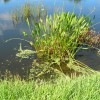This new 6-page document is intended to provide Floridians and their communities with information on a specific management practice in stormwater ponds: the use of fountains and other aeration approaches. These practices may provide opportunities both to improve water quality within the pond and protect downstream water quality. Specifically, this document gives basic information on fountains and the pros and cons of fountain installation and use. In addition, we provide information for pond managers or community decision makers on how to best manage ponds for effective pollutant removal in the pond and downstream water quality protection. Written by Samantha T. Howley, Steven P. Hohman, and Alexander J. Reisinger, and published by the UF/IFAS Department of Soil and Water Sciences.
https://edis.ifas.ufl.edu/ss695
Tag: Pond Management
Natural Climate Variability Can Influence Cyanobacteria Blooms in Florida Lakes and Reservoirs
During the summer, many of Florida's nutrient-enriched lakes and reservoirs experience proliferations of cyanobacteria commonly called “blooms.”. Cyanobacteria are natural in Florida lakes and reservoirs, but when they grow to high levels and bloom, they become a big problem. They look awful, smell bad, and can poison fish and other animals in the water. To help resource managers considering costly remediation projects or evaluating the effectiveness of nutrient reduction strategies to manage the problem, this 7-page fact sheet presents the results from 15 years of studies observing three large, nutrient-rich lakes in Florida (Lake Harris, Lake George, and Lake Okeechobee) to study the relationship between rainfall and cyanobacteria blooms and learn causes of year-to-year bloom variability. Written by Karl E. Havens, Mark V. Hoyer, and Edward J. Phlips and published by the Florida Sea Grant College Program
http://edis.ifas.ufl.edu/sg142
Florida-Friendly Plants for Stormwater Pond Shorelines (ENH1215/EP476)
 Selecting aquatic and shoreline plants for stormwater ponds is more challenging than selecting plants for a typical landscape. Site conditions can vary greatly and are more difficult to control. For example, water depth sometimes fluctuates widely, creating wet and dry conditions. Water quality varies with rainfall and fertilizer inputs. Steep slopes can make plant establishment and retention difficult. The concept of using the right plant in the right place is particularly important in the shoreline environment because the planting area includes a dry slope and a littoral shelf with shallow and deep water areas. This 4-page fact sheet recommends plants that were selected based on these three questions: 1) What environmental conditions does the plant need to grow? 2) How do you want the plant to function? 3) What do you want the plant to look like? Written by Gail Hansen and Shangchun Hu, and published by the UF Department of Environmental Horticulture, May 2013.
Selecting aquatic and shoreline plants for stormwater ponds is more challenging than selecting plants for a typical landscape. Site conditions can vary greatly and are more difficult to control. For example, water depth sometimes fluctuates widely, creating wet and dry conditions. Water quality varies with rainfall and fertilizer inputs. Steep slopes can make plant establishment and retention difficult. The concept of using the right plant in the right place is particularly important in the shoreline environment because the planting area includes a dry slope and a littoral shelf with shallow and deep water areas. This 4-page fact sheet recommends plants that were selected based on these three questions: 1) What environmental conditions does the plant need to grow? 2) How do you want the plant to function? 3) What do you want the plant to look like? Written by Gail Hansen and Shangchun Hu, and published by the UF Department of Environmental Horticulture, May 2013.
http://edis.ifas.ufl.edu/ep476
ENY856/IN825 Managing Pestiferous Freshwater Aquatic Midge Emergences From Storm Water Retention Ponds
ENY-856, a 3-page fact sheet by Kenneth T. Gioeli, Philip G. Koehler, R. Leroy Creswell, Jeffrey P. Gellermann, and Edward A. Skvarch, describes a recently developed integrated pest management plan for these tiny mosquito-like pests that can adversely impact the quality of life of residents living near storm water retention ponds. Includes references. Published by the UF Department of Entomology and Nematology, October 2009.
http://edis.ifas.ufl.edu/IN825
BUL334/FA158 Stormwater Detention and Discharge from Aquaculture Ponds in Florida
Revised! Bulletin 334, a 10-page illustrated bulletin by A. G. Smajstrla, M. E. Griggs, A. M. Lazur, J. E. Hill, and C. L. Ohs, provides engineering information on the design, construction, and installation of a relatively inexpensive trickle-flow control device for management of stormwater discharge and water conservation. It also provides information on production pond freeboard requirements and size of detention pond required. Includes references. Published by the UF Program in Fisheries and Aquatic Sciences of the School of Forest Resources and Conservation, December 2008.
http://edis.ifas.ufl.edu/FA158

